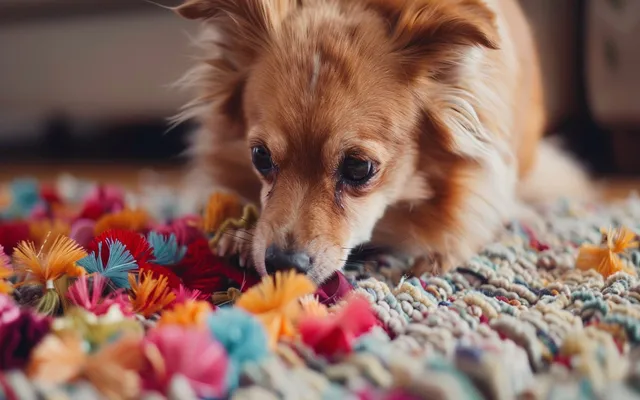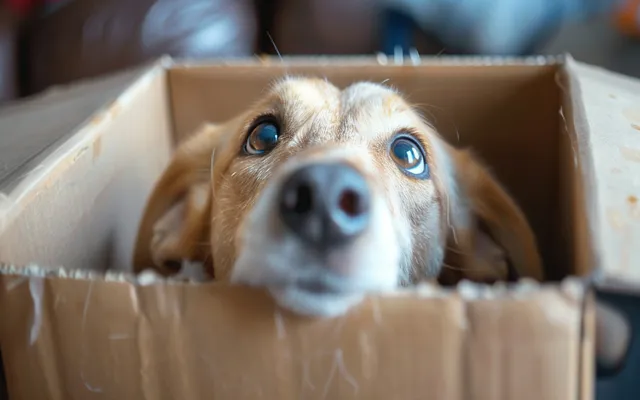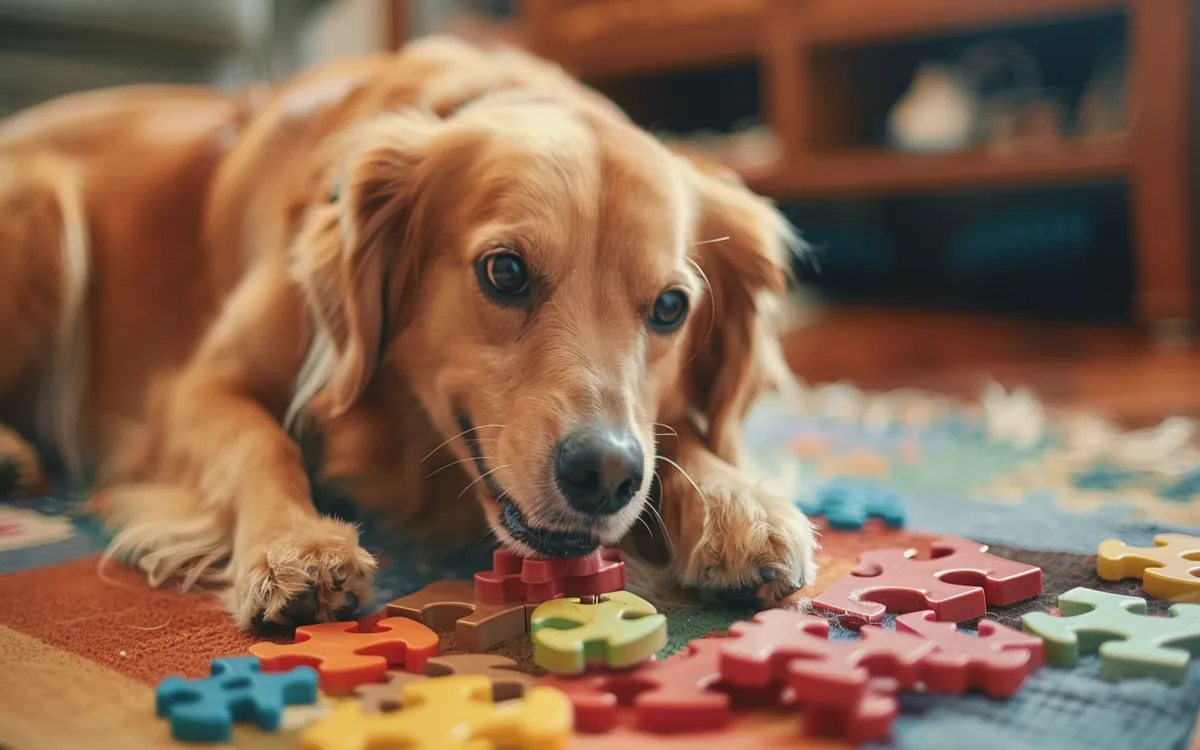Dogs are more than just pets, they’re cherished members of our families. As responsible dog owners, we strive to provide them with the best possible care, ensuring their physical and mental well-being. Mental stimulation for dogs plays a crucial role in a dog’s overall happiness and health. In this article, we’ll delve into the world of canine mental enrichment, exploring why it’s so important and unveiling. Variety of fun and engaging ways to keep your furry friend’s mind sharp and active.

What is Mental Stimulation For Dogs, and Why Does It Matter?
Mental stimulation for dogs refers to activities that challenge a dog’s mind and encourage them to think and problem-solve. It’s the equivalent of a good workout for their brain! Just like physical exercise keeps their bodies fit, mental stimulation keeps their minds sharp, preventing boredom and behavioral problems.
Mental stimulation offers a plethora of benefits for dogs, including:
- Reduced boredom and destructive behavior: A bored dog is more likely to engage in destructive behaviors like chewing, digging, or excessive barking. Mental stimulation provides an outlet for their energy and curiosity, leading to a calmer and happier pup.
- Improved cognitive function: Regular mental workouts help keep a dog’s mind agile and can even delay the onset of cognitive decline in senior dogs.
- Stronger bond with their owner: Engaging in mentally stimulating activities with your dog strengthens the bond you share, building trust and understanding.
- Increased confidence: Successfully completing mental challenges boosts a dog’s confidence and self-esteem.
How Much Mental Stimulation For Dogs Need?
The amount of mental stimulation a dog needs varies depending on their age, breed, and individual personality. However, most dogs benefit from at least 30 minutes of mental stimulation per day. This can be broken up into shorter sessions throughout the day.

A Delicious Challenge
Puzzle toys are interactive toys designed to challenge a dog’s problem-solving skills. They typically involve hiding treats or kibble inside the toy, and the dog must figure out how to manipulate the toy to release the rewards. Puzzle toys come in various shapes, sizes, and difficulty levels, catering to dogs of all ages and breeds.
How Do Puzzle Toys Work?
Puzzle toys work by requiring dogs to perform certain actions to access the hidden treats. Some toys may require the dog to paw, nudge, or roll the toy, while others may involve sliding panels, lifting flaps, or removing obstacles. The challenge lies in figuring out the right combination of actions to reach the tasty reward.
The Benefits of Puzzle Toys
- Mental Stimulation: Puzzle toys engage a dog’s cognitive abilities, forcing them to think critically and problem-solve.
- Slows Down Eating: For dogs who tend to scarf down their food, puzzle toys can help slow them down and prevent digestive issues.
- Physical Exercise: Some puzzle toys encourage physical activity, such as chasing or rolling the toy to release the treats.
- Boredom Buster: Puzzle toys provide a fun and challenging way for dogs to entertain themselves, reducing boredom and destructive behaviors.
- Weight Management: Puzzle toys can be a helpful tool for managing a dog’s weight by controlling their portion sizes and slowing down their eating habits.
Types of Puzzle Toys
The world of puzzle toys is vast and varied, with options to suit every dog’s preferences and skill level. Here are some popular types of puzzle toys:
- Treat Dispensing Toys: These toys release treats as the dog interacts with them, often requiring them to roll, paw, or nudge the toy.
- Interactive Feeders: These feeders replace traditional food bowls and require dogs to work for their meals by manipulating the feeder to release kibble.
- Snuffle Mats: These mats mimic the experience of foraging for food in grass or leaves, encouraging dogs to use their sense of smell to find hidden treats.
- Lick Mats: These mats are designed to be spread with soft food like peanut butter or yogurt, providing a soothing and engaging activity for dogs.
- Hide-and-Seek Toys: These toys involve hiding treats in compartments or under flaps, challenging dogs to find the hidden treasures.

Choosing the Right Puzzle Toy
When selecting a puzzle toy for your dog, consider their age, breed, size, and skill level. Start with a simple toy and gradually increase the difficulty as your dog masters the challenge. It’s also important to choose a toy that is durable and safe for your dog to play with.
Nose Work Games: Unleashing Your Dog’s Inner Detective

Nose work games are a fantastic way to tap into your dog’s natural instincts and provide them with a stimulating and rewarding activity. These games involve hiding treats or toys and encouraging your dog to use their powerful sense of smell to locate them. Nose work games can be played indoors or outdoors, making them a versatile option for mental stimulation.
How Nose Work Games Work
Nose work games typically start with a simple setup, such as hiding a few treats in cardboard boxes or under overturned cups. As your dog becomes more proficient, you can increase the difficulty by hiding treats in more challenging locations or introducing new scents, such as essential oils or spices.
The Benefits of Nose Work Games
- Mental Stimulation: Nose work games engage a dog’s brain, requiring them to focus, concentrate, and problem-solve.
- Physical Exercise: While not as physically demanding as running or fetching, nose work games can still provide a moderate amount of exercise as dogs move around to search for the hidden treasures.
- Stress Relief: Nose work games can be a calming and relaxing activity for dogs, helping to reduce stress and anxiety.
- Confidence Building: Successfully finding the hidden treats or toys can boost a dog’s confidence and self-esteem.
- Bonding with Owner: Nose work games are a fun and interactive way to bond with your dog, strengthening your relationship and building trust.
How to Play Nose Work Games
- Start Simple: Begin with a few easy hides, such as placing treats in open boxes or under easily accessible objects.
- Use High-Value Rewards: Initially, use treats or toys that your dog finds particularly enticing to motivate them to search.
- Give Verbal Cues: Encourage your dog with verbal cues like “find it” or “search.”
- Increase Difficulty: As your dog masters the basics, gradually increase the difficulty by hiding treats in more challenging locations, using different containers, or introducing new scents.
- Make it Fun: Keep the games fun and positive, rewarding your dog for their efforts even if they don’t find all the hides.
Conclusion
Investing time and effort in providing your dog with mental stimulation is an investment in their overall well-being. A mentally stimulated dog is a happy, healthy, and well-adjusted dog. By incorporating puzzle toys, nose work games, training, socialization, and environmental enrichment into their lives, you can help them thrive both mentally and physically.
FAQs
How can I mentally stimulate my senior dog who has limited mobility?
Focus on activities that don’t require a lot of physical exertion, such as puzzle toys, scent work, and gentle training sessions. You can also try food puzzles that are easier to manipulate and adjust the difficulty of nose work games.
Can I overstimulate my dog with too many mental activities?
Yes, it’s possible to overstimulate a dog, especially if they are not used to a lot of mental activity. Signs of overstimulation can include hyperactivity, restlessness, and difficulty settling down. Start slowly and gradually increase the amount of mental stimulation you provide.
Are there specific breeds that require more mental stimulation than others?
Yes, some breeds, like Border Collies, Australian Shepherd, and Poodles, are known for their high intelligence and energy levels and may require more mental stimulation than other breeds. However, every dog is an individual, so it’s important to pay attention to your dog’s specific needs.
Can mental stimulation help with separation anxiety in dogs?
Yes, providing your dog with plenty of mental stimulation before you leave can help tire them out and reduce anxiety while you’re gone. Puzzle toys, chew toys, and food puzzles are all great options for keeping your dog occupied while you’re away.

Healthy dogs mean happy dogs, and that makes me happy! I’m here to share all the tips for keeping your best furry friend in top shape, from puppyhood to their golden years.

